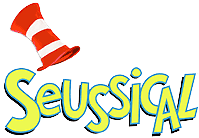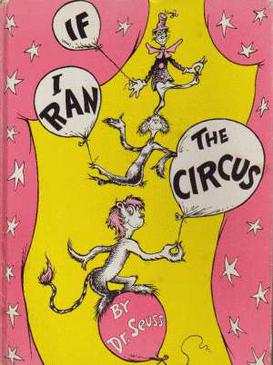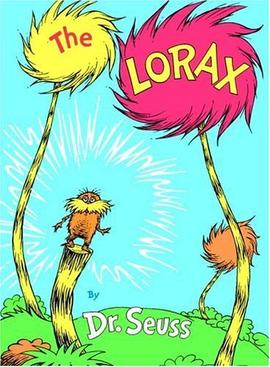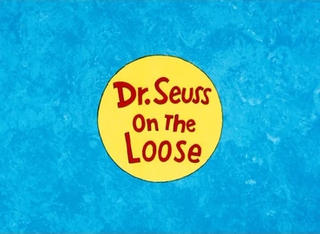
Theodor Seuss Geisel was an American children's author and cartoonist. He is known for his work writing and illustrating more than 60 books under the pen name Dr. Seuss. His work includes many of the most popular children's books of all time, selling over 600 million copies and being translated into more than 20 languages by the time of his death.

The Cat in the Hat is a 1957 children's book written and illustrated by American author Theodor Geisel, using the pen name Dr. Seuss. The story centers on a tall anthropomorphic cat who wears a red and white-striped top hat and a red bow tie. The Cat shows up at the house of Sally and her brother one rainy day when their mother is away. Despite the repeated objections of the children's fish, the Cat shows the children a few of his tricks in an attempt to entertain them. In the process, he and his companions, Thing One and Thing Two, wreck the house. As the children and the fish become more alarmed, the Cat produces a machine that he uses to clean everything up and disappears just before the children's mother comes home.

Seussical is a musical comedy by Lynn Ahrens and Stephen Flaherty, based on the many children's stories of Dr. Seuss, with most of its plot being based on Horton Hears a Who!, Gertrude McFuzz, and Horton Hatches the Egg while incorporating many other stories. The musical's name is a portmanteau of "Seuss" and the word "musical". Following its Broadway debut in 2000, the show was widely panned by critics, and closed in 2001 with huge financial losses. It has spawned two US national tours and a West End production, and has become a frequent production for schools and regional theaters.
The Dr. Seuss National Memorial Sculpture Garden is a sculpture garden at the Quadrangle in Springfield, Massachusetts, which honors Theodor Seuss Geisel, better known as Dr. Seuss, who was born in Springfield in 1904. The monument was designed by Lark Grey Dimond-Cates, the author's stepdaughter, and created by sculptor and artist Ron Henson.

Yertle the Turtle and Other Stories is a picture book collection by Theodor Seuss Geisel, published under his more commonly known pseudonym of Dr. Seuss. It was first released by Random House Books on April 12, 1958, and is written in Seuss's trademark style, using a type of meter called anapestic tetrameter. Though it contains three short stories, it is mostly known for its first story, "Yertle the Turtle", in which the eponymous Yertle, king of the pond, stands on his subjects in an attempt to reach higher than the Moon—until the bottom turtle burps and he falls into the mud, ending his rule.

Oh, the Places You'll Go! is a children's book, written and illustrated by children's author Dr. Seuss. It was first published by Random House on January 22, 1990. It was his last book to be published during his lifetime before his death, on September 24, 1991 at the age of 87. The book concerns the journey of life, its challenges, and joys.

The Grinch is a fictional character created by children's author and cartoonist Dr. Seuss. He is best known as the main character of the 1957 children's book How the Grinch Stole Christmas! He has been portrayed and voiced by many actors, including Boris Karloff, Hans Conried, Bob Holt, Walter Matthau, Anthony Asbury, Jim Carrey, Rik Mayall, Benedict Cumberbatch, Matthew Morrison, David Howard Thornton, and James Austin Johnson.

If I Ran the Circus is a children's book by Dr. Seuss, published in 1956 by Random House.

Robert John Holthaus, better known as Bob Holt, was an American actor, best known for his voice work.

The Lorax is a children's book written by Dr. Seuss and published in 1971. It chronicles the plight of the environment and the Lorax, the main character, who "speaks for the trees" and confronts the Once-ler, a business magnate who causes environmental destruction.

In Search of Dr. Seuss is a 1994 American television film chronicling the adventures of a news reporter, Kathy Lane, who enters the world of Dr. Seuss by opening a magical book. Also starring are Matt Frewer, Christopher Lloyd, Andrea Martin, David Paymer, Patrick Stewart, Andraé Crouch, Robin Williams and Eileen Brennan.

Dr. Seuss on the Loose is an American animated musical television special, first airing on CBS on October 15, 1973, and was sponsored by Nestlé. The special is hosted by The Cat in the Hat, who introduces animated adaptations of the Dr. Seuss stories The Sneetches, The Zax and Green Eggs and Ham. Allan Sherman reprised his role as the voice of The Cat in the Hat from the 1971 television special, which marked his final role prior to his death on November 20, 1973. The special became a popular annual repeat for most of the decade until its last CBS showing on July 12, 1979.
The Cat in the Hat is an American animated musical television special originally broadcast March 10, 1971 on CBS. It was based on the 1957 Dr. Seuss children's story of the same name, and produced by DePatie–Freleng Enterprises. With voices by Allan Sherman and prolific vocal performer Daws Butler, this half-hour special is a loose adaptation of the book with added musical sequences.
The Lorax is a musical Dr. Seuss animated short produced by DePatie–Freleng Enterprises which first aired as a television special on CBS in the United States on February 14, 1972, and in Canada on CBC Television on October 22, 1972. The special was written by Theodor Geisel, based on his 1971 book of the same name.
Razi Hirmandi (with the real name of Seyed Mohammad Razi Khodadadi is an Iranian writer/translator who translates from English into Persian for children and adults.

The Lorax, also known as Dr. Seuss' The Lorax, is a 2012 American animated musical fantasy comedy film produced by Illumination Entertainment and distributed by Universal Pictures. The film is the second screen adaptation of Dr. Seuss' 1971 children's book of the same name following the 1972 animated television special. Directed by Chris Renaud, co-directed by Kyle Balda, produced by Chris Meledandri and Janet Healy and written by the writing team of Cinco Paul and Ken Daurio, it stars the voices of Danny DeVito, Ed Helms, Zac Efron, Taylor Swift, Rob Riggle, Jenny Slate and Betty White.
Theodor Seuss Geisel, better known as Dr. Seuss, published over 60 children's books over the course of his long career. Though most were published under his well-known pseudonym, Dr. Seuss, he also authored a certain amount of books as Theo. LeSieg and one as Rosetta Stone.
Dr. Seuss Goes to War: The World War II Editorial Cartoons of Theodor Seuss Geisel is a 1999 book written by Richard H. Minear, containing Dr. Seuss's political cartoons created during World War II.
Anna Sarfatti is an Italian writer of children's books.

The Lorax is a stage adaptation of the children's novel of the same name by Dr. Seuss, with the Television Special And The 2012 Film Adaptation adapted by David Greig and featuring songs by Charlie Fink.














